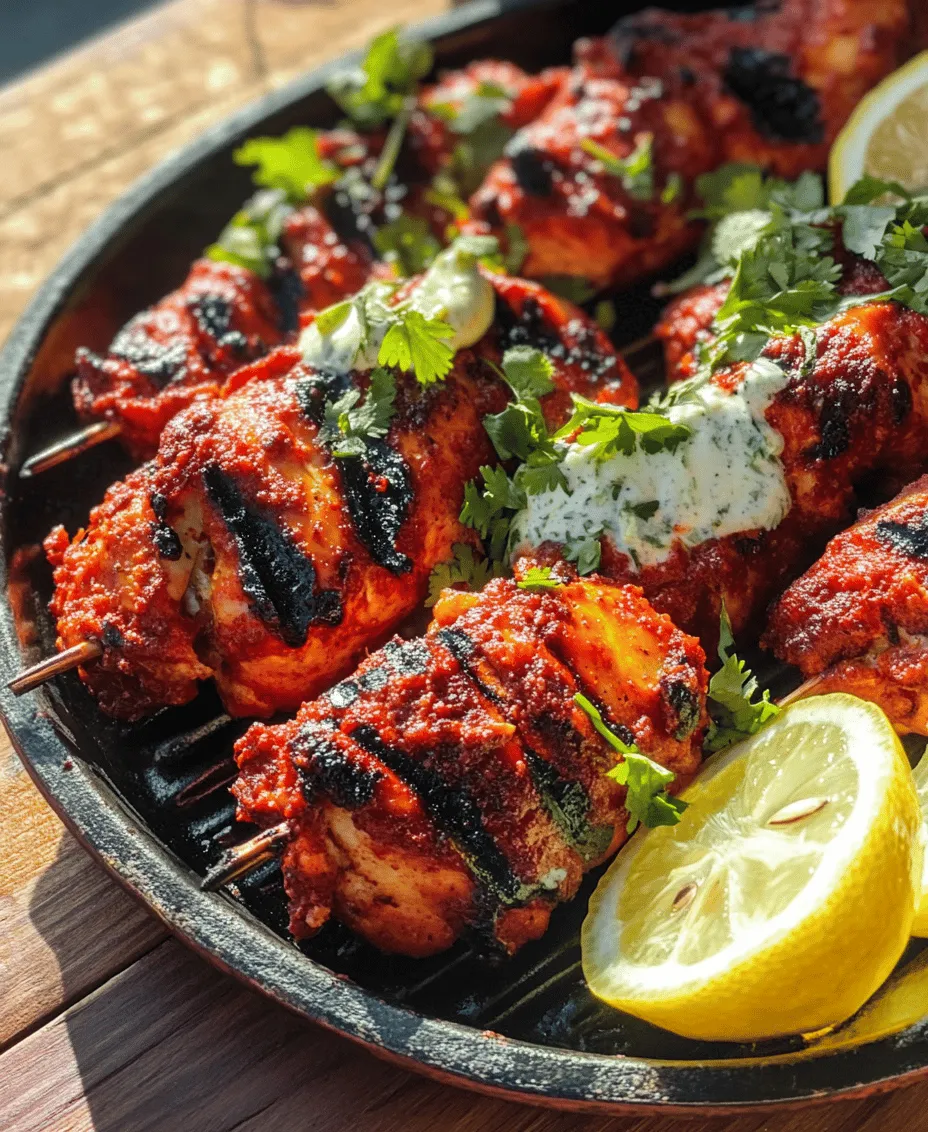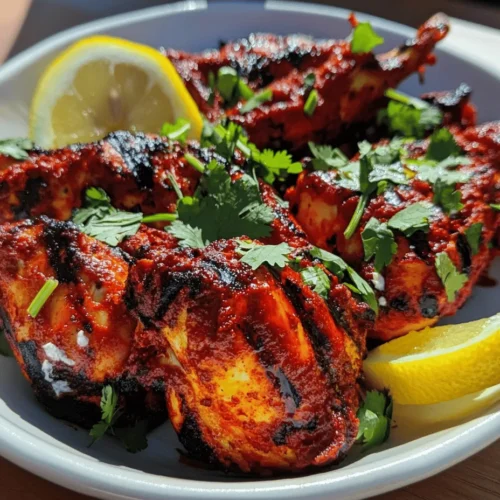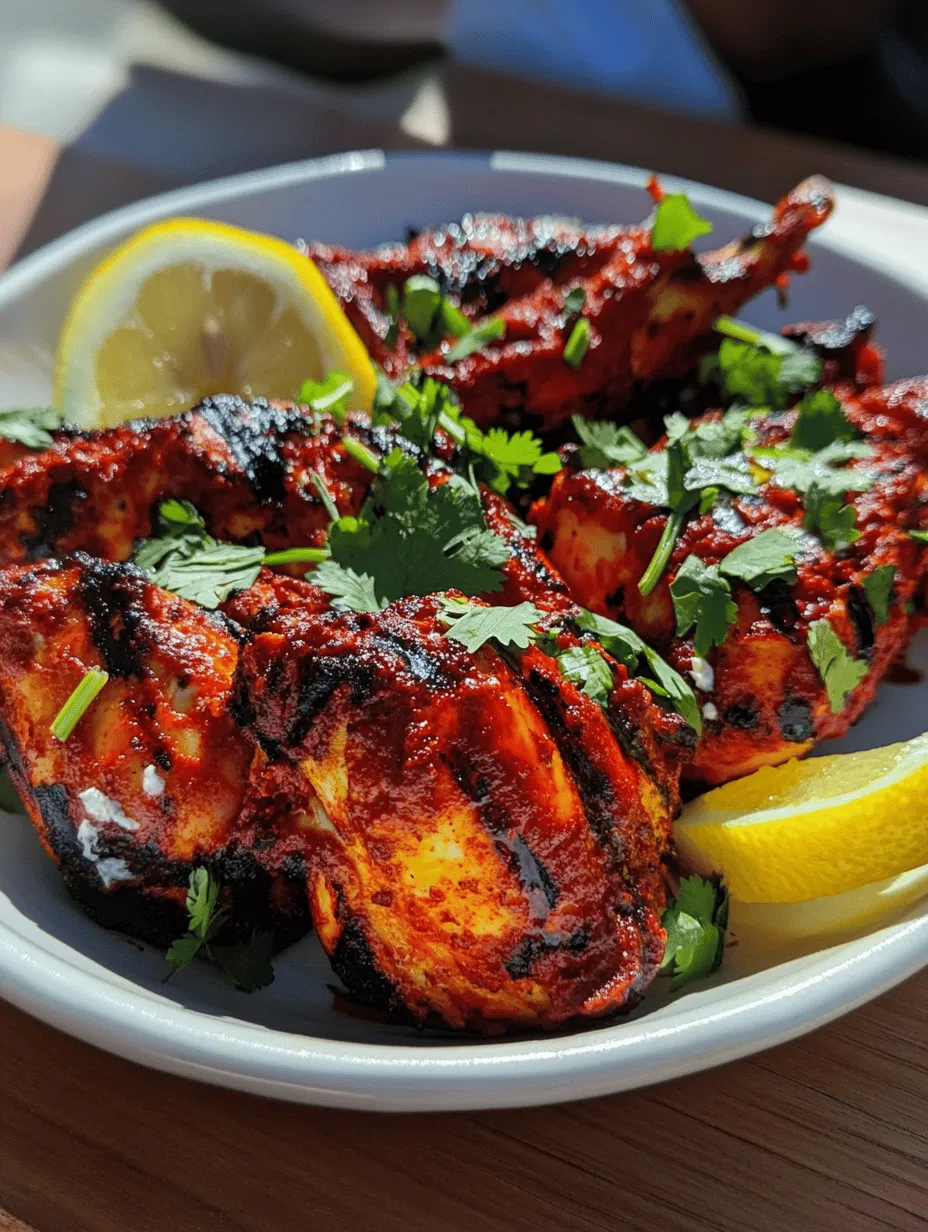Introduction
Grilled Tandoori Chicken is a dish that captures the essence of Indian cuisine, bringing together a symphony of spices, marinated chicken, and the distinctive smoky flavor of the grill. Originating from the Indian subcontinent, Tandoori chicken is traditionally cooked in a tandoor—a clay oven that reaches high temperatures, giving the chicken its signature charred exterior while locking in moisture. This dish is not just a meal; it’s a celebration of flavors and aromas that transport you straight to the bustling streets of India.
The key to achieving the authentic flavors associated with Tandoori chicken lies in the marination process. Marinating the chicken allows it to absorb the rich spices and yogurt mixture, which infuses the meat with flavor and tenderizes it. This step is crucial for a balanced and deeply satisfying dish. In this article, we’ll explore how to create perfectly grilled Tandoori chicken, delving into its origins, essential ingredients, and the marination process that brings it all together.
Moreover, grilling is a healthier alternative to frying, allowing the natural flavors of the chicken and spices to shine through without the added fat. By opting to grill, you not only enhance the taste but also reduce calorie intake, making this a delicious yet health-conscious choice for any gathering or everyday meal.
Understanding Tandoori Chicken
Tandoori chicken is more than just a popular dish; it is a cultural icon in Indian cuisine, representing the rich culinary heritage of the region. The name “Tandoori” is derived from the “tandoor,” the traditional clay oven that has been used for centuries to prepare various dishes, not just chicken. The unique cooking method involves marinating the chicken in a mixture of yogurt and spices before cooking it at high temperatures, allowing the meat to become tender and infused with flavor.
The cultural significance of Tandoori chicken extends beyond its taste; it reflects the communal aspect of Indian dining. Often enjoyed at celebrations, family gatherings, and festivals, this dish brings people together to savor the bold and aromatic flavors that define Indian cooking. Tandoori chicken has also gained global popularity, making its way onto menus in restaurants around the world, further showcasing its versatility and appeal.
The primary ingredients in Tandoori chicken contribute to its distinctive taste profile. The use of yogurt not only adds creaminess but also acts as a tenderizing agent, breaking down proteins in the chicken for a juicier bite. The combination of spices—such as cumin, coriander, turmeric, and garam masala—creates a complex flavor that is both spicy and aromatic. Each ingredient plays a vital role in building the dish’s character and depth, making it a culinary experience that tantalizes the taste buds.
Ingredients Breakdown
Creating the perfect Grilled Tandoori Chicken starts with selecting the right ingredients. Below is a detailed breakdown of each component and its purpose in the dish.
Whole Chicken
When choosing a whole chicken for Tandoori, size and type matter. Opt for a free-range or organic chicken if possible, as it tends to have a richer flavor and better texture. A medium-sized bird (around 3 to 4 pounds) is ideal, as it allows for even cooking and sufficient meat to absorb the marinade. Additionally, consider the cut; while whole chicken is traditional, you can also use chicken thighs or drumsticks for a more accessible option.
Yogurt
Plain yogurt is a cornerstone of Tandoori chicken marinades. It serves multiple purposes: it contributes a creamy texture, acts as a tenderizer, and helps the spices adhere to the chicken. The acidity in yogurt breaks down the meat fibers, resulting in a tender and juicy final product. For the best results, use full-fat plain yogurt; it enhances flavor and moisture levels, ensuring your chicken is succulent after grilling.
Spices
The spices used in Tandoori chicken are what truly elevate the dish. Tandoori masala, a blend of various spices, is key to achieving the traditional flavor. Common spices include:
– Cumin: Adds a warm, earthy flavor.
– Coriander: Offers a hint of sweetness and citrusy notes.
– Turmeric: Provides the characteristic golden color and a subtle bitterness.
– Garam Masala: A blend of spices like cinnamon, cardamom, and cloves, contributing warmth and complexity.
In addition to Tandoori masala, ground red chili powder or cayenne pepper can be added for heat, depending on your spice preference. These spices create a vibrant and aromatic profile that is synonymous with Indian cuisine.
Fresh Ingredients
Fresh garlic and ginger are essential in Tandoori chicken marinades. Their bold flavors not only complement the spices but also enhance the overall taste of the dish. Garlic contributes a pungent, savory quality, while ginger adds a warm, peppery kick. Together, they create a well-rounded flavor base that is integral to the Tandoori experience.
Optional Ingredients
While the above ingredients form the foundation of Tandoori chicken, there’s room for creativity. Some cooks like to add lemon juice or vinegar to the marinade for extra acidity, which can further assist in tenderizing the meat and brightening the flavors. Fresh herbs, such as cilantro or mint, can also be incorporated for a fresh twist. Consider your personal preferences and feel free to experiment with additional spices or flavorings that resonate with your taste.
Preparing the Marinade
Creating the marinade for your Grilled Tandoori Chicken involves combining the selected ingredients into a cohesive mixture that will infuse the chicken with flavor. Here’s a step-by-step guide to crafting the perfect marinade:
1. Gather Your Ingredients: Start by measuring out your yogurt, spices, garlic, ginger, and any optional ingredients you plan to use. Having everything ready will streamline the process.
2. Mix the Marinade: In a large mixing bowl, combine the yogurt with the spices. Start with the Tandoori masala, adding approximately two tablespoons for a standard chicken. Then, incorporate cumin, coriander, turmeric, and chili powder, adjusting to your desired spice level.
3. Add Fresh Ingredients: Grate fresh garlic and ginger directly into the mixture. You can use a microplane for a fine texture, ensuring they blend seamlessly into the marinade.
4. Balance the Flavors: Taste the marinade and consider adding a splash of lemon juice or vinegar for brightness. Adjust seasonings as necessary to create a well-balanced flavor profile.
5. Make Ahead: If you want to save time, prepare the marinade a day in advance and store it in the refrigerator. This allows the flavors to meld and intensify, enhancing the overall taste when applied to the chicken.
Marinating the Chicken
Once the marinade is prepared, it’s time to marinate the chicken. This crucial step allows the flavors to penetrate the meat thoroughly. Here’s how to do it effectively:
1. Prepare the Chicken: Before marinating, rinse the chicken under cold water and pat it dry with paper towels. This process removes any residual moisture from the surface, allowing the marinade to cling better.
2. Make Slashes: For optimal flavor penetration, make several shallow slashes in the chicken, especially on the thighs and breast. This technique creates channels for the marinade to seep into the meat, ensuring a flavorful bite.
3. Coat the Chicken: Generously apply the marinade all over the chicken, ensuring every nook and cranny is covered. Use your hands to massage the marinade into the slashes and crevices, which will help in flavor absorption.
4. Marination Time: Cover the marinated chicken with plastic wrap or place it in a resealable bag, and refrigerate. For the best results, marinate the chicken for at least 4 hours, although overnight is ideal. The longer the chicken sits in the marinade, the more pronounced the flavors will be.
5. Bring to Room Temperature: Before grilling, allow the marinated chicken to sit at room temperature for about 30 minutes. This helps promote even cooking on the grill.
By following these steps, you’ll ensure that your Grilled Tandoori Chicken is bursting with flavor and tender to perfection. In the next part of this article, we will delve into the grilling techniques and tips for achieving that coveted char and smoky flavor that Tandoori chicken is known for.

The Science Behind Marination
Before we dive into the grilling process, understanding the science behind marination helps us appreciate why Tandoori chicken is so flavorful and tender. Marination is a process in which meat is soaked in a mixture of acidic ingredients, spices, and sometimes oil, allowing the flavors to penetrate deep into the meat. The acidic components, such as yogurt and lemon juice used in Tandoori chicken, play a crucial role in tenderizing the meat by breaking down proteins. This not only enhances flavor but also improves texture, making the chicken juicy and succulent.
The spices added during marination, including cumin, coriander, and paprika, not only contribute to the dish’s rich taste but also offer health benefits. Many spices are known for their antioxidant properties and can aid digestion. The longer you marinate the chicken—ideally overnight—the more pronounced these flavors will become, resulting in a dish that bursts with taste.
Setting Up Your Grill
When it comes to grilling Tandoori chicken, the type of grill you choose can significantly impact the outcome.
Types of Grills
1. Gas Grills: These are convenient and allow for precise temperature control. They are great for quick cooking and are easy to clean, making them ideal for weeknight meals or gatherings.
2. Charcoal Grills: For those who enjoy the traditional smoky flavor, charcoal grills are the way to go. They take longer to heat up, but the deep, rich flavor imparted by the charcoal can elevate your Tandoori chicken to new heights.
Preheating Tips
Regardless of the grill type, preheating is essential for even cooking. Aim to preheat your grill to medium-high heat (around 400-450°F). For gas grills, turn on all burners and close the lid for about 10-15 minutes. For charcoal grills, once the coals are ashed over, spread them evenly and let them heat for a few minutes before placing the chicken on the grill.
Safety Precautions
Grilling comes with its own set of safety precautions. Always ensure your grill is placed on a stable surface away from flammable materials. Keep a spray bottle of water nearby to manage flare-ups. Use long-handled utensils to prevent burns and always allow the grill to cool before cleaning.
Grilling the Chicken
Now that your grill is prepped and ready, it’s time to grill the chicken.
Grilling Technique
1. Placement: Start by oiling the grill grates lightly to prevent sticking. This will also impart a slight flavor to the chicken. Place the marinated chicken pieces on the grill, ensuring they are spaced apart to allow for even cooking.
2. Cooking Time and Temperature: Grill the chicken for about 6-8 minutes on each side, depending on the thickness of the pieces. The goal is to achieve a nice char on the outside while keeping the inside juicy.
3. Using a Meat Thermometer: To ensure food safety, it’s essential to check the internal temperature of the chicken. The USDA recommends that chicken reaches a minimum internal temperature of 165°F. A meat thermometer is your best friend here; insert it into the thickest part of the chicken without touching the bone.
Resting and Serving the Chicken
Once your chicken is grilled to perfection, it’s time to let it rest.
Why Resting is Crucial
Resting is an often-overlooked step in cooking that allows the juices to redistribute throughout the meat. If you cut into the chicken immediately, the juices will run out, leaving you with dry meat. Allow the grilled Tandoori chicken to rest for at least 5-10 minutes before serving.
Garnishing and Pairing Suggestions
To elevate your Tandoori chicken, consider garnishing it with fresh cilantro and lemon wedges. The brightness of the lemon cuts through the richness of the chicken, enhancing the overall flavor.
For sides, traditional accompaniments include:
– Naan: Soft Indian bread perfect for scooping up the chicken.
– Rice: Fragrant basmati rice pairs beautifully with the spices.
– Salads: A fresh cucumber and tomato salad adds a refreshing crunch.
Nutritional Benefits of Grilled Tandoori Chicken
Grilled Tandoori chicken is not just delicious; it also offers numerous health benefits.
Overview of Health Benefits
The primary ingredients used in Tandoori chicken—yogurt, spices, and lean chicken—are all nutrient-dense. Yogurt is a great source of protein and calcium, while spices like turmeric and cumin have anti-inflammatory properties. Additionally, grilling is a healthier cooking method compared to frying, as it allows excess fat to drip away from the meat.
Comparison of Cooking Methods
Grilling retains more nutrients in the chicken compared to frying or baking, where the meat may lose moisture and become dry. Moreover, the high temperatures in grilling can also produce compounds that are beneficial for health.
Nutritional Value of a Serving of Tandoori Chicken
A standard serving of grilled Tandoori chicken (approximately 3.5 ounces) contains around 200 calories, 20 grams of protein, and is low in fat, especially if you trim the skin. The spices and yogurt used in the marinade contribute minimal calories but add significant flavor and health benefits.
Conclusion
In summary, making perfect grilled Tandoori chicken involves understanding the marination process, setting up your grill correctly, and employing the right grilling techniques. Resting the chicken and serving it with complementary sides can transform your meal into a delightful feast.
Whether you are hosting a summer barbecue or looking for a flavorful weeknight dinner, Tandoori chicken is versatile and appealing. Embrace the journey of homemade cooking and let the vibrant flavors of Indian cuisine bring joy to your table. Your taste buds will thank you, and your family will appreciate the effort you put into making this delicious dish from scratch. Enjoy the delightful experience of grilling and savor every bite of your Tandoori chicken masterpiece.



